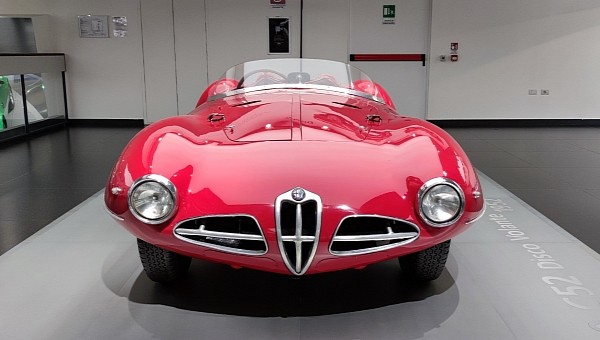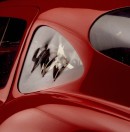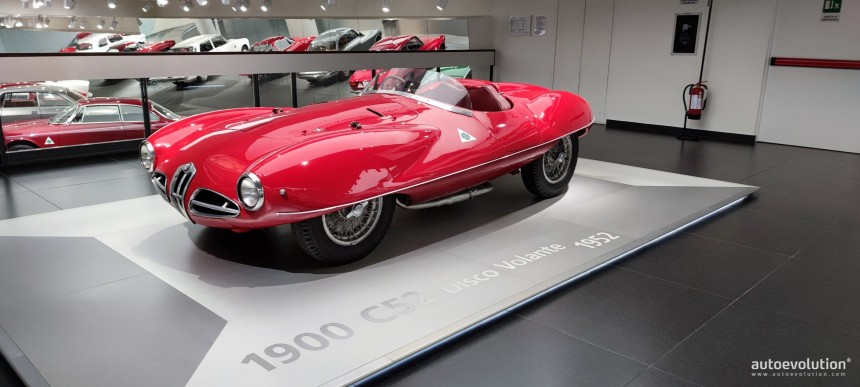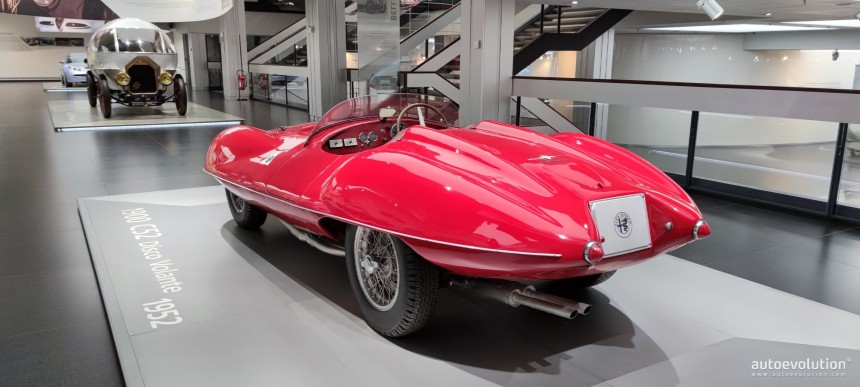Alfa Romeo blessed us car enthusiasts with many iconic designs over the years. From the superb 6C series to sporty coupes like the GTV and mid-engine masterpieces such as the Tipo 33 Stradale, there’s a lot to like about the Milanese automaker. I’ve recently had the opportunity to admire many of these classics at Museo Storico Alfa Romeo in Arese, which is a short bus trip away from Milan. Amidst the many historical automobiles displayed there, the 1900 C52 Disco Volante absolutely wowed me in every single respect.
The red-painted flying saucer on wheels in Arese is the very first chassis produced. Chassis number 1359.00001 was joined by four other siblings, and today, four examples of the bite-the-back-of-your-hand beautiful C52 are known to exist. In addition to the spider that left me speechless in the metal, the Italian automaker also produced a coupe-bodied example, a narrow-bodied spider, and two spiders with 6C 3000 CM mechanicals.
How did the C52 come to be? It all started with Alfa Romeo dropping from the king of motorized sports after dominating the 1950 and 1951 seasons with Farina and Fangio behind the wheel. Their weapons of choice, namely the 158 and updated 159 version of the Alfetta, were both masterminded by a Legnano-born engineer.
Gioacchino Colombo is best known for the naturally-aspirated V12 that powered Ferrari between 1947 and 1988, its final application being the underrated 412i. The Italian engineer originally apprenticed for Vittorio Jano. With Alfa Romeo not convinced by the Formula 1 regulations introduced for the 1952 season, the company tasked Gioacchino with developing a sports racing car.
Designed in collaboration with Milan-based Carrozzeria Touring Superleggera under the supervision of head designer Carlo Felice Bianchi Anderloni, the C52 never saw racing action, at least not officially. It’s based on the road-going 1900, which proved woefully uncompetitive at the 1952 Giro d’Sicilia and Mille Miglia. Breathtaking from every angle, the C52 broke cover at the 1952 New York International Motor Sports Show due to Max Hoffman.
The company’s U.S. importer intended to sell a few examples to customers, but Hoffman would ultimately get none. Alfa Romeo planned to enter the C52 at Le Mans that year, but upon returning to Italy, the Italian automaker discovered reliability and stability issues during testing. Nicknamed flying saucer due to its unconventional appearance, the Disco Volante was relegated from racing project to experimental test bed.
Although the 1900 uses a monocoque, the engineers behind the C52 decided on a tubular steel chassis with side rails. Dressed in light alloy, the C52 uses the double wishbones and live axle of the 1900 C Sprint that failed to impress at the Giro d’Sicilia and Mille Miglia. Originally equipped with Pirelli rubber boots wrapped around 16-inch wire wheels with duralumin rims, this flamboyant machine boasts drum brakes fore and aft.
Tipping the scales at 735 kilograms (1,620 pounds) and capable of hitting more than 220 kilometers per hour (137 miles per hour) with the right gearing, the C52 produces 158 ps (156 horsepower) at 6,500 revolutions per minute from a displacement of 1,997 cubic centimeters. The four-cylinder DOHC powerplant of the 1900 was understandably modified for this application. The compression ratio, for example, was raised from 7.7 to 8.7:1 to suit the 2.0-liter engine’s double-barrel carbs.
As mentioned earlier, two units were assembled with 6C 3000 CM oily bits. One of them was dismantled soon after its construction, whereas 1361.00011 is currently on display at Museo Nazionale dell’Automobile. Chassis 1361.00012 was dismantled immediately after Alfa Romeo understood that the C52 won’t win any races.
Chassis 1359.00002 is one of the first three cars built with the aforementioned four-cylinder lump rather than the inline-six engine of the 6C 3000 CM. This example had its Touring coachwork replaced by a more conventional body in 1952. This change is why it’s known as Fianchi Stretti, translating to narrow hips.
1359.00003 also started life with Touring’s flying saucer-like bodywork. During the summer of 1952, it would be rebodied as a berlinetta. Displayed at the 1953 Turin Motor Show, the 2.0-liter coupe was retained by Alfa Romeo. It remains on display at Museo Storico Alfa Romeo, yet when I visited the museum in January 2023, it wasn’t there alongside chassis 1359.00001. Another notable absence was the Tipo 33 Stradale, but on the upside, I was thrilled by the museum’s 33 racing cars.
With Alfa Romeo’s blessing, Carrozzeria Touring reimagined the C52 in the 2010s with the confusingly named Alfa Romeo Disco Volante by Touring. Confusing as in the original was also bodied by Touring. As opposed to its predecessor, which used a custom-designed spaceframe, the second coming features the chassis and powertrain of the limited-edition 8C Competizione. Penned by Louis de Fabribeckers, the coupe-bodied special edition was followed by a spider.
Only seven units of the latter have been finished, each painted in a different color. The demonstrator shown at the 2016 Geneva Motor Show is finished in an elegant shade of blue over beige and black leather upholstery. The open-top model packs the 8C Competizione’s (or - better said - 8C Spider’s) naturally-aspirated V8, a Maserati engine produced by Ferrari. In combination with an automated manual rather than a dual-clutch tranny, the Disco Volante Spyder by Touring hits 100 kilometers per hour (62 miles per hour) in 4.2 seconds.
How did the C52 come to be? It all started with Alfa Romeo dropping from the king of motorized sports after dominating the 1950 and 1951 seasons with Farina and Fangio behind the wheel. Their weapons of choice, namely the 158 and updated 159 version of the Alfetta, were both masterminded by a Legnano-born engineer.
Gioacchino Colombo is best known for the naturally-aspirated V12 that powered Ferrari between 1947 and 1988, its final application being the underrated 412i. The Italian engineer originally apprenticed for Vittorio Jano. With Alfa Romeo not convinced by the Formula 1 regulations introduced for the 1952 season, the company tasked Gioacchino with developing a sports racing car.
Designed in collaboration with Milan-based Carrozzeria Touring Superleggera under the supervision of head designer Carlo Felice Bianchi Anderloni, the C52 never saw racing action, at least not officially. It’s based on the road-going 1900, which proved woefully uncompetitive at the 1952 Giro d’Sicilia and Mille Miglia. Breathtaking from every angle, the C52 broke cover at the 1952 New York International Motor Sports Show due to Max Hoffman.
Although the 1900 uses a monocoque, the engineers behind the C52 decided on a tubular steel chassis with side rails. Dressed in light alloy, the C52 uses the double wishbones and live axle of the 1900 C Sprint that failed to impress at the Giro d’Sicilia and Mille Miglia. Originally equipped with Pirelli rubber boots wrapped around 16-inch wire wheels with duralumin rims, this flamboyant machine boasts drum brakes fore and aft.
Tipping the scales at 735 kilograms (1,620 pounds) and capable of hitting more than 220 kilometers per hour (137 miles per hour) with the right gearing, the C52 produces 158 ps (156 horsepower) at 6,500 revolutions per minute from a displacement of 1,997 cubic centimeters. The four-cylinder DOHC powerplant of the 1900 was understandably modified for this application. The compression ratio, for example, was raised from 7.7 to 8.7:1 to suit the 2.0-liter engine’s double-barrel carbs.
As mentioned earlier, two units were assembled with 6C 3000 CM oily bits. One of them was dismantled soon after its construction, whereas 1361.00011 is currently on display at Museo Nazionale dell’Automobile. Chassis 1361.00012 was dismantled immediately after Alfa Romeo understood that the C52 won’t win any races.
1359.00003 also started life with Touring’s flying saucer-like bodywork. During the summer of 1952, it would be rebodied as a berlinetta. Displayed at the 1953 Turin Motor Show, the 2.0-liter coupe was retained by Alfa Romeo. It remains on display at Museo Storico Alfa Romeo, yet when I visited the museum in January 2023, it wasn’t there alongside chassis 1359.00001. Another notable absence was the Tipo 33 Stradale, but on the upside, I was thrilled by the museum’s 33 racing cars.
With Alfa Romeo’s blessing, Carrozzeria Touring reimagined the C52 in the 2010s with the confusingly named Alfa Romeo Disco Volante by Touring. Confusing as in the original was also bodied by Touring. As opposed to its predecessor, which used a custom-designed spaceframe, the second coming features the chassis and powertrain of the limited-edition 8C Competizione. Penned by Louis de Fabribeckers, the coupe-bodied special edition was followed by a spider.
Only seven units of the latter have been finished, each painted in a different color. The demonstrator shown at the 2016 Geneva Motor Show is finished in an elegant shade of blue over beige and black leather upholstery. The open-top model packs the 8C Competizione’s (or - better said - 8C Spider’s) naturally-aspirated V8, a Maserati engine produced by Ferrari. In combination with an automated manual rather than a dual-clutch tranny, the Disco Volante Spyder by Touring hits 100 kilometers per hour (62 miles per hour) in 4.2 seconds.




































